Sushi is an original Japanese food that has conquered gastronomy around the world. Usually composed of a filling, a layer of rice and a strip of nori (type of leaf made with seaweed).
Although there are traditional sushi, like nigiri and temaki, some restaurants sometimes change fillings and flavors creating their own versions and adding a touch of local cuisine to the dish.
Currently, the cuisine has a wide variety of sushi, offering to the public, including vegan and fried sushi.
Check out the main types of sushi below.
nigrizushi

Popularly known as nigiri (or niguiri), this type of sushi consists of a hand-molded rice ball. The preparation includes a little wasabi and a topping made with a thin layer of fish.
O wasabi is a pasty-textured and spicy-tasting seasoning widely used in Japanese cuisine.
The type of fish used to make Nigirizushi can vary depending on the time of year; fish of the season is usually used.
The most commonly used are salmon, tuna, sea bass, snapper, cockerel and halibut.
There are also varieties of nigiri whose rice is covered with seafood such as shrimp, squid, octopus and cockles.
Depending on the type of topping, it may or may not be attached to the rice ball with a small strip of nori.
Gunkanzushi
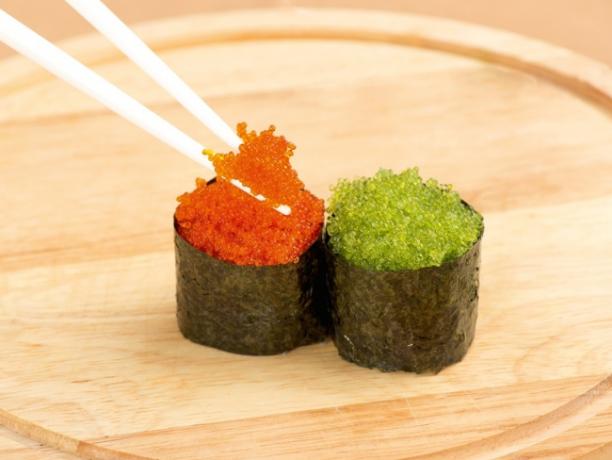
Also called gunkanmaki and gunkan, gunkanzushi is a sushi whose size is slightly smaller compared to other varieties.
Made by hand, this type of sushi is formed by a rice base covered by the filling that, instead of being in the middle, is placed on top.
One of the most commonly used ingredients as a filling/topping for Gunkanzushi is fish eggs.
The delicacy is finished with a strip of nori that wraps it.
Varieties whose coverage consists of small pieces of tuna, salmon or omelet are also common.
Makizushi
Makizushi is a general nomenclature used to designate generally cylindrical sushi wrapped in a nori sheet.
Within this category, the most common sushi are:
Hossomaki
Hossomaki has the typical and traditional composition of sushi: a filling that is wrapped in a layer of rice wrapped in a nori leaf.
A peculiarity of hossomaki is that the rolls are slightly thinner than the rolls of other sushi varieties. For this reason, most of the time, hossomaki has only one filling.
The thickness of the delicacy is present in its own name: man means "fine" and maki means "coiled", that is, hossomaki means "thin coiled".
The main types of hossomaki are the shakemaki, O kappamaki it's the tekkamaki.
Shakemaki
Shakemaki is the traditional rolled sushi with a salmon filling. For this reason, shakemaki is often also known simply as salmon maki.
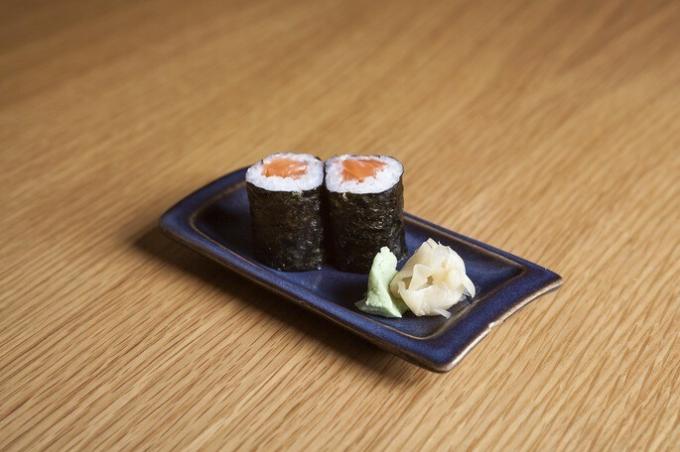
Kappamaki

Unlike most hossomakis, kappamaki do not have a filling made up of pieces of fish or shellfish, but rather of pieces or slices of cucumber.
A curious fact is that, in addition to being a vegan sushi, your name is inspired by kappa, a mythological being of Japanese folklore, whose favorite food is cucumber.

Kappa is a green amphibian that has a turtle-like shell and a hole in its head with a liquid that is said to be its source of power. It is said that when this hole is injured or when liquid is spilled, the Kappa loses its power.
Tekkamaki
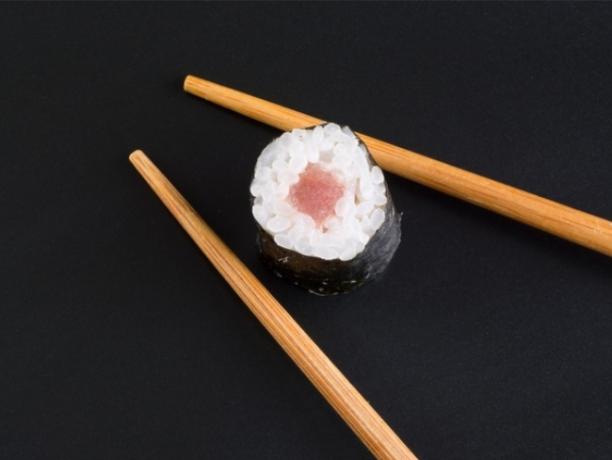
Despite the similarity with traditional types of sushi, what characterizes tekkamaki is the fact that its filling is exclusively composed of tuna.
Uramaki
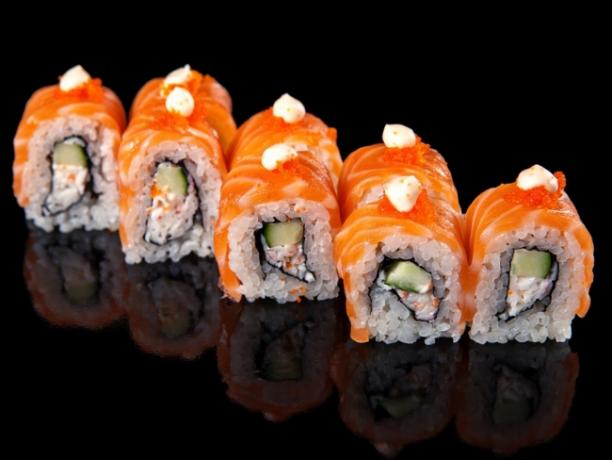
The term "uramaki", like the term "makizushi", is a general nomenclature used to designate any type of sushi that has a rolled nori sheet.
So, at first, it looks like sushi like the others. However, it has a peculiar characteristic.
Unlike other types of sushi, it has a nori strip on the inside, directly surrounding the filling.
Due to this particularity, some say that uramaki is a sushi turned inside out.
During the 1960s, when sushi began to gain fame, some customers complained about the texture of nori. So, a chef had the idea of hiding it inside the delicacy, creating a type of sushi.
Difference between hossomaki and uramaki
What differentiates a hossomaki from a uramaki is the way they are "assembled".
In hossomaki, nori (seaweed) is rolled on the outside, thus consisting of the outermost layer of sushi. In the uramaki (upside down roll), the nori is an inner layer, which surrounds the filling and is surrounded by a layer of rice.
Despite these differences, both are classified as makizushi, that is, they are rolled sushi.
futomaki
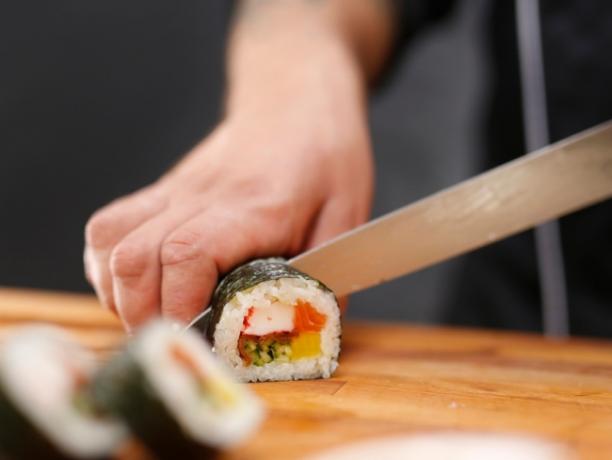
Futomaki is a cylindrical sushi that is much larger than other varieties of sushi.
Due to its larger circumference, futomaki tends to have much more filling.
The base for the futomaki filling is composed by Tamagoyaki, which is a kind of typically Japanese omelet.
In addition to the omelet, the futomaki filling includes a variety of combined ingredients, such as ginger, vegetables, fish and roots.
Temaki
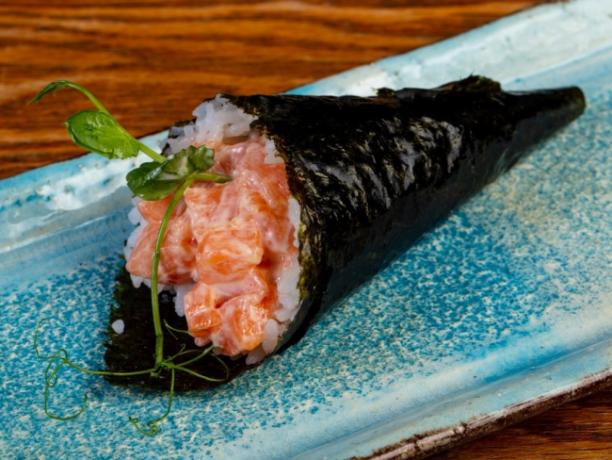
Temaki is perhaps the most peculiarly shaped sushi of all because it is large and cone-shaped.
Despite being a type of rolled sushi, it is different from other makizushi because it is not formed by layers.
Composed of a hand-rolled nori leaf in a conical shape, the temaki is filled with rice, raw fish, seafood, vegetables and/or fruits to the brim.
hot rolls
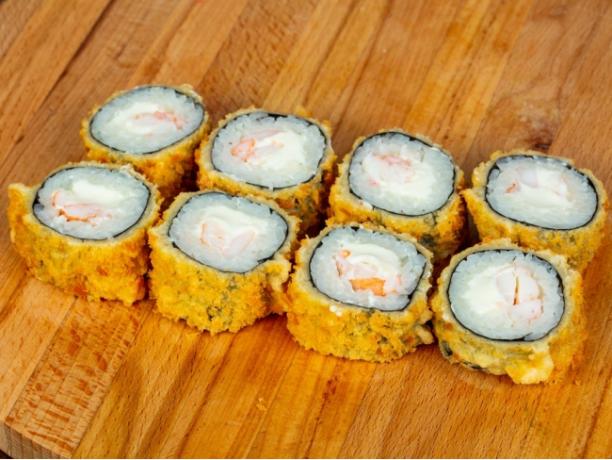
Hot rolls are rolled sushi, composed of stuffing, a layer of rice and a strip of nori that wraps it.
After compounding, the hot rolls are breaded and fried.
They are a great alternative for those who are afraid to eat sushi because of the raw ingredients, for example.
One of the most common types of hot rolls are filled with cream cheese and called hot philadelphia alluding to the name of a famous brand of this type of cheese. There is also the hot skin, which is filled with the crispy skin of the fish.
know more about cream cheese.
Sushi Joe

Sushi Joe, whose spelling has become popular in several ways (such as, for example, Jow, DJ and DJ), is one of the few types of sushi that does not have the nori leaf in its composition.
It is a simple preparation sushi made like a rice ball wrapped in a thin strip of fish and which can be covered with roe, pieces of fish and/or various seasonings.
Sushi Joe is said to have been created improvised by a chef nicknamed Joe, in a restaurant where, halfway through, the nori leaves ran out.
In order to continue fulfilling customer requests, the chef would have decided to replace the nori with fish strips.
Difference between sushi and sashimi
Although there are a large number of Japanese food lovers all over the world, there are still many questions regarding what sushi really is and what sashimi is.
The truth is that, despite both being delicacies that are part of oriental cuisine, they are different types of dishes.
Contrary to what many people think, sashimi is not a type of sushi.
While sushi is made up of stuffing or topping, rice and nori, sashimi is a piece of raw fish or seafood that can be consumed with a sauce shoyo or wasabi.

Sashimi
know more about Sashimi and wasabi.
Curiosity
A very curious fact about sushi is that, originally, it was prepared quite differently.
The Japanese used to "pack" fish in rice and let it rest long enough for a fermentation process to take place.
Once the process was complete, only the fish was consumed and the rice was thrown away.
know more about Sushi.
